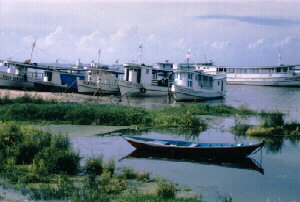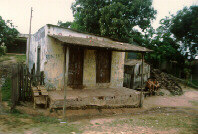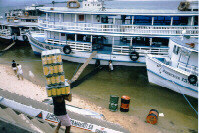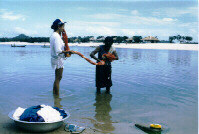About
SantarΘm
Related Links
|
SantarΘm
 SantarΘm is located along the Amazon river, half-way between Manaus and
SantarΘm – where the clear green waters of the Tapaj≤s merge with the murky brown
waters of the Amazon. SantarΘm is located along the Amazon river, half-way between Manaus and
SantarΘm – where the clear green waters of the Tapaj≤s merge with the murky brown
waters of the Amazon.
SantarΘm is the third-largest city on the Brazilian Amazon. But it is very unlike the
big cities of Manaus and BelΘm. With only 60,000 people, it looks and feels more like a
frontier town from an old Western movie. Famous cowboys, like John Wayne and Randolph
Scott, would feel at home here. The town has red dirt roads, rough wooden shacks, and the
atmosphere of the "supermercado" (supermarket) is more like that of an old-style
General Store. It seems fitting that SantarΘm was settled in 1867 by 110 Confederate
refugees fleeing the South after the American Civil War.
 The farms around the SantarΘm look to be very recent – as if they’ve
only just been cleared out of the rainforest. The land is hot and dusty, and all around
the town there are big black vultures, called Urub·s, which scavenge through rubbish
along the streets and riverfront. The sight of these vultures is very unnerving – as
I wander down the city’s main street I can spy a huge group of them watching me from
the roof of a nearby building. Another six or seven are even closer, perched along the top
of a billboard. The farms around the SantarΘm look to be very recent – as if they’ve
only just been cleared out of the rainforest. The land is hot and dusty, and all around
the town there are big black vultures, called Urub·s, which scavenge through rubbish
along the streets and riverfront. The sight of these vultures is very unnerving – as
I wander down the city’s main street I can spy a huge group of them watching me from
the roof of a nearby building. Another six or seven are even closer, perched along the top
of a billboard.
 Appearances are deceiving. SantarΘm looks like a new town which isn’t yet
finished, but its much older than any New Zealand town or city. Before Europeans arrived,
it was the centre of a thriving Indian culture, the Tapuiτu. The first European
settlement was a Jesuit mission built in 1661. The present town grew up around this
mission, and was officially named SantarΘm in 1758. Appearances are deceiving. SantarΘm looks like a new town which isn’t yet
finished, but its much older than any New Zealand town or city. Before Europeans arrived,
it was the centre of a thriving Indian culture, the Tapuiτu. The first European
settlement was a Jesuit mission built in 1661. The present town grew up around this
mission, and was officially named SantarΘm in 1758.
I will be visiting here to learn more about the area’s history, and about
developments such as FordlΓndia and nearby goldmines. Many locals wear heavy gold chains,
and some readily talk about the fortunes that they've won and lost. Not far from SantarΘm
is another town, called Alter do Chπo – the most beautiful place that I’ve yet
seen in Amaz⌠nia.
SantarΘm used to be the centre of a large Indian civilisation, but very little is
known about how they lived because few of the Indians survived past the arrival of the
Europeans. The first European explorers and settlers brought diseases with them, which
made the Indians very sick – causing many to die. The Indians’ survival was also
hampered by the fact that many of the first Europeans to visit here were slave raiders.
They captured entire Indian tribes then transported them far away to live and work on
plantations. However, the first explorer to arrive here reported that he saw prosperous
Indian villages where the people raised turtles in riverside pens, and made fine pottery.
The ancient civilisation was almost completely forgotten, until 1922, when a rainstorm
washed away part of a road and uncovered a treasure-trove of ancient stone tools and
pottery. A more recent discovery is Caverna da Pedra Pintada which contains ancient Indian
artefacts – some dated at over 11,000 years old.
There are several places of interest in and around SantarΘm. These include:
 The Waterfront The Waterfront
The waterfront along the front of the town is where you can see riverboats being loaded
up. There are even floating petrol stations where the riverboats can fill up with fuel.
There are markets along the waterfront selling fresh fruit, fish, dried shrimps, and other
produce. Livestock is also exchanged here, so you might see interesting sights such as
live chickens in cages, or farmers struggling to get a stubborn pigs onto the back of a
truck.
 Alter do Chπo Alter do Chπo
Alter do Chπo is a small town along the Tapaj≤s river. The beauty of its clear
lakes and white sand beaches meant that it became a sacred place for the local Indians.
However, now it is a popular holiday and weekend destination for the people of SantarΘm.
- Caverna da Pedra Pintada.
The area around SantarΘm is well-known to archaeologists and researchers for its rock
paintings and artefacts belonging to earlier Amazonian cultures. The discoveries in
Caverna da Pedra Pintada are particularly interesting because they are over 11,000 years
old and indicate that people had adapted to life in Amaz⌠nia's tropical rainforests long
before previously thought. [Related Article]
- FordlΓndia
A few hours up the Tapaj≤s river from SantarΘm is a rubber plantation called
FordlΓndia. It was built by the famous car-maker, Henry Ford, during the 1930s. Ford
tried creating a plantation similar to the successful rubber plantations of Ceylon (Sri
Lanka) and Malaysia. It was intended to guarantee a cheap source of rubber for the Ford
Motor Company. [More]
- Goldmines
Goldmines are another recent development. Enormous deposits of gold was discovered along
the Tapaj≤s river, bringing tens of thousands of people into the area with hopes of
making their fortune. The new goldmines caused problems with pollution and uncontrolled
development of the region. [More]
- Floresta Nacional do Tapaj≤s and
Parque Nacional da Amaz⌠nia
With development taking place all around the region, several areas have been set aside as
reserves and nature areas. Floresta Nacional do Tapaj≤s covers an area of 650,000
hectares, and Parque Nacional da Amaz⌠nia covers about a millions hectares. These are
places where visitors can experience natural rainforests and see wild animals. Despite
their huge size, the parks are generally under-resourced and operate with minimum staff
(there are only four park rangers available to monitor the entire 1 million hectare Parque
Nacional da Amaz⌠nia).
|